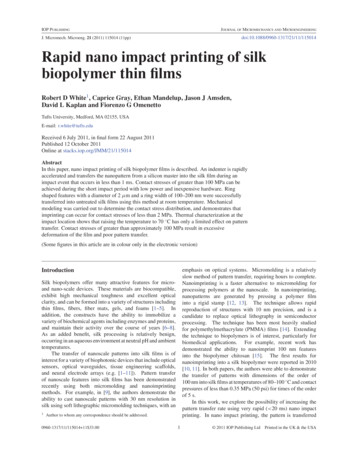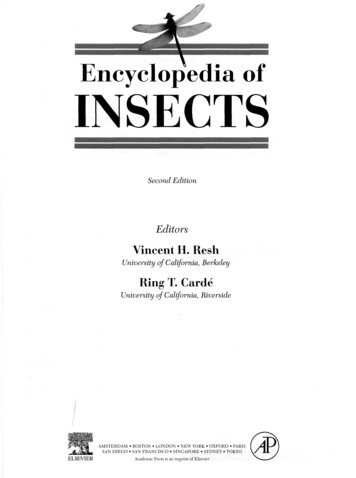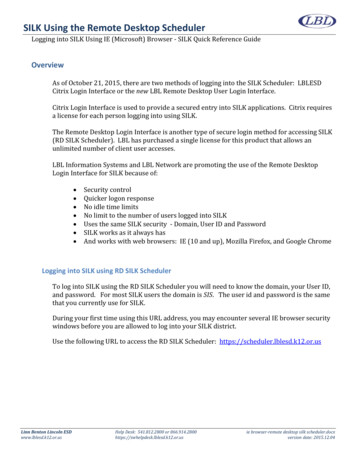
Transcription
Articlepubs.acs.org/LangmuirSilk Layering As Studied with Neutron ReflectivityBrett Wallet,† Eugenia Kharlampieva,† Katie Campbell-Proszowska,† Veronika Kozlovskaya,†Sidney Malak,† John F. Ankner,‡ David L. Kaplan,§ and Vladimir V. Tsukruk*,††School of Materials Science and Engineering, Georgia Institute of Technology, Atlanta, Georgia 30332, United StatesSpallation Neutron Source, Oak Ridge National Laboratory, Oak Ridge, Tennessee 37831, United States§Department of Biomedical Engineering, Tufts University, Medford, Massachusetts 02155, United States‡ABSTRACT: Neutron reflectivity (NR) measurements of ultrathinsurface films (below 30 nm) composed of Bombyx mori silk fibroinprotein in combination with atomic force microscopy and ellipsometrywere used to reveal the internal structural organization in both dry andswollen states. Reconstituted aqueous silk solution deposited on asilicon substrate using the spin-assisted layer-by-layer (SA-LbL)technique resulted in a monolayer silk film composed of randomnanofibrils with constant scattering length density (SLD). However, avertically segregated ordering with two different regions has beenobserved in dry, thicker, seven-layer SA-LbL silk films. The verticalsegregation of silk multilayer films indicates the presence of a differentsecondary structure of silk in direct contact with the silicon oxidesurface (first 6 nm). The layered structure can be attributed tointerfacial β-sheet crystallization and the formation of well-developed nanofibrillar nanoporous morphology for the initiallydeposited silk surface layers with the preservation of less dense, random coil secondary structure for the layers that follow. Thissegregated structure of solid silk films defines their complex nonuniform behavior in the D2O environment with thicker silk filmsundergoing delamination during swelling. For a silk monolayer with an initial thickness of 6 nm, we observed the increase in theeffective thickness by 60% combined with surprising decrease in density. Considering the nanoporous morphology of thehydrophobic silk layer, we suggested that the apparent increase in its thickness in liquid environment is caused by the airnanobubble trapping phenomenon at the liquid solid interface. water-soluble glycoprotein that binds fibroin filaments,1 andalthough it contributes to increased mechanical properties ofsilk, it also has detrimental effects on the integration of silk intooptical and biomedical devices.21A balance of assorted forces including van der Waals,electrostatic, entropic, steric, hydrogen bonding, and hydrophobic interactions determines the secondary structure of silkmolecules adsorbed at various interfaces.22 The uniqueproperties of silk materials are caused by their order disordermultidomain structure resulting from silk fibroin consisting ofalternating hydrophobic and hydrophilic domains. Silk proteinis rich in glycine and alanine residues, and the presence ofGAGAS amino acid repeats are responsible for the formation ofα-helices and β-sheet crystalline regions separated by randomcoil segments. 23 The transition between random coilconformation and silk crystalline ordering can be induced bychanging solvent quality, drying conditions, and solventtreatments. Although the overall behavior of silk fibroin insolution and in bulk is fairly well understood, secondary silkstructures at interfaces and close proximity to surfaces remain aINTRODUCTIONThe control of the structural organization of proteins atinterfaces with inorganic materials is crucially important for thedesign of bio-nanocomposite materials. Biology is full ofexamples in which material interfaces have been designed andassembled to provide unique properties, and strategies havebeen demonstrated to exhibit specific molecular control overthese interfaces through self-assembly driven processes.1,2Recently, silk fibroin protein has become an appealingbiomaterial for implementation as a major component ofhybrid biocomposites with applications ranging from sensingand optical systems to advanced structural composites.3 9Several inherent physical properties suggest silk fibroin as aprospective candidate material in these areas including opticaltransparency, biocompatibility, biodegradability, and highstrength combined with elasticity and mechanical robustness.10,11 The processing challenges in handling these highmolecular weight proteins without aggregation has led to theuse of reconstituted or regenerated silk fibroin aqueous solutionfor the fabrication of silk films and complex topologicalstructures such as fibers and microcapsules.10,12 20 Productionof silk fibroin solution for composite formation starts with thepurification of harvested Bombyx mori cocoons by removingsericin, the glue-like binding component of silk. Sericin is a 2012 American Chemical SocietyReceived: March 3, 2012Revised: June 10, 2012Published: June 14, 201211481dx.doi.org/10.1021/la300916e Langmuir 2012, 28, 11481 11489
LangmuirArticlesolvent is the only way to reveal any inhomogeneities related tointerfacial reorganization in secondary structures such as βsheet crystallization.Thus, in the present communication, we report on neutronreflectivity studies conducted on ultrathin, molecular-level silkfilms ( 30 nm) in combination with atomic force microscopyimaging, spectroscopic ellipsometry studies, and previous FTIRdata. Ultrathin films were fabricated using a reconstituted silkfibroin solution and spin-assisted layer-by-layer (LbL)assembly. Details regarding the interfacial behavior of silkmacromolecules are revealed and depict a direct influence ofthe silicon oxide surface on structural organization within thefilms. We also demonstrate, via multiple silk layer deposition,the ability to tailor the structural density of these films bycreating a silk template that becomes more dilute at the film air interface at a certain distance from the substrate. In addition,the effect of swelling of the films with D2O solvent is presentedin order to provide information regarding film organization andstability at the solid liquid interface.significant technical challenge. For example, the formation ofhelical structures at air liquid interfaces as a polymorph of silkhave been reported.24,25 These studies demonstrate that thecrystalline structure, silk III, involves a left-handed, threefoldhelical chain conformation with hexagonal packing of silkmolecules. Side chain character influences the stabilization of aninterfacial conformation, suggesting that hydrophobic/hydrophilic interactions and partitioning drive the silk conformationat the air liquid interface. However, information is still lackingregarding how increasing distance from the interface affects thesilk chain conformation. Furthermore, the behavior of silk filmsin liquids, as well as their ability to swell after tethering tointerfaces, remains uncharted.In our recent study, we conducted ATR-FTIR of silk onsilicon substrates and revealed that spin-assisted depositionimmediately induced crystalline silk II formation from silk Istructure (random coil conformation) in ultrathin films.11 Thistransformation is believed to be facilitated via exposure of theultrathin silk layer ( 5 nm) to air in combination with shearforces, causing rapid dehydration of the film. In contrast, arelatively thick ( 100 nm) dry spin-cast film displayed apredominantly random-coil structure under ambient conditions. The result is indicative of different structures pertainingto the ultrathin film versus the thicker one and the occurrenceof significantly segregated interfacial structures. However, thesestudies provide only information on average conformation ofsilk molecules in particular films and cannot address thequestion of localized and propagating segregated phenomenaand the effect of the interfacial confinement along the surfacenormal.As is known, X-ray and neutron reflectivity techniques arecapable of probing phenomena throughout thin films andrevealing how interfacial interactions affect gradient of orderingalong the surface normal26 29 with a spatial resolution at lengthscales ranging from submicrometers to that of intermoleculardistances.30 Several studies have been conducted using thecombination of X-ray and neutron reflectivity techniques toinvestigate protein adsorption at interfaces,31 34 while variousothers focus solely on neutron reflectivity measurements toobtain desired adsorption information.35 38 Furthermore,neutron reflectivity has shown promising results for characterization of multilayer polymer films with inhomogeneousdistribution of components.39 42However, most studies on silk fibroin have involved X-raydiffraction measurements of bulk materials to determine thestructural characteristic of its three known conformations(random coil, silk I, and silk II) and do not provide insight intointernal structuring of deposited silk layers.43 46 However, Xray reflectivity does not provide the necessary contrast since theelectron density contrast for biological systems is generallylow,47 49 and the overall film microstructure composition issimilar. On the other hand, neutron reflectivity examines lengthscales relevant for investigation of interactions of proteins andpolymers, and adsorption of these molecules at liquid and solidsurfaces.30 An additional advantage of neutron reflectivity forthis study is that the neutron scattering contrast betweendifferent isotopes of hydrogen, protium (1H) and deuterium(2H), can be exploited for examination of the swelling effect inultrathin silk films. The high contrast of the absorptiondistribution across the interface is critical for obtaining richstructural information from nanostructured biopolymer inorganic interfaces in the swollen state.50 It is important tonote that neutron reflectivity from silk swollen in contrasted EXPERIMENTAL SECTIONReconstituted Silk Fibroin Solution. For all experiments, 18.2MΩ·cm Nanopure water was utilized. Silk was obtained from Bombyxmori silkworms raised on a diet of Silkworm Chow (Mullberry Farms,Fallbrook, CA). Live pupae were extracted from the cocoons prior tosericin removal. Cocoons were boiled for 30 min in an aqueoussolution of 0.02 M Na2CO3 and then rinsed thoroughly with distilledwater to extract the gluelike sericin proteins. The extracted silk fibroinwas then dissolved in 9.3 M LiBr solution at 60 C for 4 h, yielding a20% (w/v) solution. The solution was dialyzed against distilled waterusing Slide-a-Lyzer dialysis cassettes (Pierce, MWCO 3500) at roomtemperature for 3 days to remove the LiBr. After dialysis, the solutionwas centrifuged three times, each at 20 C for 20 min, to removeimpurities and the aggregates that occurred during dialysis. The finalconcentration of aqueous fibroin solution was 8.0% w/v, determinedby weighing the remaining solid after drying. This solution was thendiluted to obtain the desired 0.2% (w/v) silk concentration used forsolution deposition.Film Formation. Silk solution was spin coated on ⟨100⟩ siliconwafers with a diameter of 5 cm, thickness of 10 mm, and one polishedside (purchased from the Institute of Electronic Materials Technology,Poland). A schematic demonstration of the deposition procedure isillustrated in Figure 1. The spin-assisted layer-by-layer (SA-LbL)deposition method was performed by sequentially dropping silk ontothe silicon substrate using 3 mL shots of silk solution, rotating for 60 sat 3000 rpm on a spin-coater (Laurell Technologies), rinsing oncewith Nanopure water to remove unbound silk, followed by depositionof the next layer in accordance with usual procedure.68 After filmfabrication, the films were dried in ambient conditions for neutronreflectivity measurements. The LbL assembly method was usedbecause it allows for the production of ultrathin films with greatercontrol over thickness, composition, and properties at the nanometerscale.51 55 We have already demonstrated the applicability of SA-LbLfor designing robust and flexible ultrathin films with excellentmechanical properties.10 Furthermore, we have established the abilityto fabricate similar films using the SA-LbL deposition approach inconjunction with reconstituted silk fibroin aqueous solution.11,13,56,57Film Characterization. The morphology of the pristine silk filmswas first characterized with a Dimension 3000 instrument (DigitalInstruments) by conducting atomic force microscopy (AFM) imagingin the light tapping mode according to the established procedure usingsilicon tips with a cantilever spring constant of 50 N m 1.58,59Ellipsometry measurements of film thickness were performed with aWoollam M2000U multiangle spectroscopic ellipsometer withmeasurements at three different angles: 65 , 70 , and 75 . Thicknessesof dry films were determined using a data fit with the Cauchy modelover the range of wavelengths, λ, of 250-1000 nm.11482dx.doi.org/10.1021/la300916e Langmuir 2012, 28, 11481 11489
LangmuirArticleunit summed over all atoms in the repeat unit, and MW is the molarmass of a representative repeat unit of the polymer.Therefore, the SLD varies as a function of the mass density of thefilm as well as the local composition in the film.61 Standard SLD valueswere used for common materials including D2O (6.38 10 6 Å 2) andsilicon oxide (3.76 10 6 Å 2) unless otherwise noted. Layerintermixing was simulated by error function density profiles (Gaussianroughness).62 The swelling profile for (silk)1 was calculated as a ratioof all characteristic dimension points (e.g., midranges of transitionzones and zones with constant SLD) in dry and in-fluid states as willbe discussed below. RESULTS AND DISCUSSIONSpectroscopic ellipsometry and AFM measurements were takenfor independent verification of the film morphologies, roughness, and different layer thicknesses in the dry state (Table 1).Table 1. Total Film Thicknesses and Microroughnesses(AFM and ellipsometry) for Dry and Swollen Silk FilmsSA-LbL systemFigure 1. Schematic representation of the film assembly process.SiO2(silk)1(silk)7Neutron Reflectivity. Neutron reflectivity measurements wereconducted on dry and hydrated SA-LbL films at the SpallationNeutron Source Liquids Reflectometer (SNS-LR) at Oak RidgeNational Lab (ORNL). The SNS-LR collects specular reflectivity datain a continuous-wavelength band at several different incident angles.Measurements were conducted in three independent series to ensurethe reproducibility of the experimental data.For the data presented here, we used the wavelength band of 0.2 nm λ 0.55 nm and measured reflectivity at angles of θ 0.15, 0.25,0.40, 0.75, and 1.20 , thereby spanning a wide total wavevectortransfer range of 0.06 nm 1 Q 1.2 nm 1 where Q (4π sin θ)/λwhere θ is the incident angle and λ is the neutron wavelength). Thedata were collected at each angle with incident-beam slits set tomaintain the wavevector resolution constant at δQ/Q 0.05, whichallowed us to stitch the five different angle data sets together into asingle reflectivity curve. We collected neutron reflectivity data from dryfilms as well as in a liquid environment by placing specimens in aliquid-cell with the top surface in contact with D2O. Isotopicsubstitution of protium with deuterium, known as the contrastvariation method, is frequently implemented due the large SLDcontrast between the two when compared to hydrogen, thus enabling aclear distinction between structural inhomogeneities in the liquid statewhich cannot be otherwise revealed.39,41,45,61,67The data were analyzed using a model developed at ORNL withconventional NR data fitting techniques. To fit the experimental data,we started with an idealized film structure featuring sharp interfacesbetween adjacent layers. This model was then modified toaccommodate the physically measured structures by adjusting layerthicknesses, scattering length density (SLD), and roughness to bestmodel the measured data in both dry and swollen states.60Initial individual layer thicknesses for simulations were taken fromellipsometry measurements and then adjusted to the neutronreflectivity data. The neutron scattering density is defined as Σ b/V, where b is the monomer scattering length (sum of the scatteringlengths of constituent atomic nuclei) and V is the monomer volume.60The value of (b/V)n can be related to the molecular properties of thefilm through:(b/V )n total film thicknessby NR (nm)AFMroughness(nm)2.04.4 27.8 1.26.09.031.0 0.13.2 0.4 2.4 0.5 The film parameters determined from modeling the measuredreflectivity data, thickness, SLD (Nb), and internal roughness(σ), are summarized in Table 2 with results discussed below.Table 2. Neutron Reflectivity Model Parameters for Dry andSwollen FilmsSA-LbLsystemSiO2(silk)1 dry(silk)1swollen(silk)7 dryNb 10 6(nm 2)d(nm)roughness(nm)SiO2silk monolayerdense silk (substrate)3762101851.26.05.50.52.00.9slightly swollen/expanded silkD2Odensely packed silk(substrate)loosely packed silk (airinterface)1103.52.5638100 6.0 5.54425.020.0modeled film structureDry Silk Films. AFM imaging of silk films in the dry stateindicates relatively smooth, uniform surfaces over large areaswithout the presence of large microscale defects, a commonfeature of SA-LbL films from silk materials. Some nanofibrillarcomponents with open porous morphology were visible forboth silk films, a common feature for SA-LbL silk films.63 Somelarger-scale surface segregation becomes visible for thicker silkfilms, which may cause dissolution and delamination of thesurface elements after long-term storage in liquid environmentsas will be discussed below.At higher magnification, the characteristic fine domaintexture was observed with domain dimensions below 50 nm,which are organized into elements of nanofibrillar structures ashas been observed and discussed for ultrathin silk films earlier(Figure 2).63,64 The domains are smaller in the thicker film andshow a higher tendency to form random nanofibrillar structuresNAρb biMWdryswollendryswollenellipsometrythickness (nm)(1)where NA is Avogadro’s number, ρb is the mass density in the volumeof interest, bi is the scattering length of the ith element in the repeat11483dx.doi.org/10.1021/la300916e Langmuir 2012, 28, 11481 11489
LangmuirArticleFigure 2. Topographical AFM images at different scales of (a, c) (silk)1 monolayer and (b, d) (silk)7 multilayer films.probed with very different wavelengths (Tables 1, 2). Forsimplicity, we refer to these films below as thin and thick for(silk)1 and (silk)7 films, respectively.In Figure 3, log R is plotted as a function of momentumtransfer, Q. For both silk films there were no distinct Braggand highly porous morphology. This is likely caused by thelonger exposure to wet conditions during multiple depositionswhich promotes the formation of nanofibrillar structures athydroxyl-terminated silicon oxide surfaces.63 A distinct featureof both surfaces is extremely high porosity with pore sizesbelow 50 nm and high estimated surface coverage which caneasily reach 50% for the topmost layer.The surface microroughness of the silk films calculated over a1 1 μm2 surface area resulted in similar values of 3.2 0.4nm and 2.4 0.5 nm for the (silk)1 and (silk)7 films,respectively, reflecting the similarity of the domain texture ofthe topmost silk layer. Through modeling of the neutronreflectivity data, the global surface roughness can be determinedfor comparison to AFM data by using the σ value associatedwith the modeled layer nearest the air interface (Tables 1, 2).The external roughness values obtained from neutronreflectivity increase to 20 nm for dry (silk)7 films, reflecting arough and diffuse surface for thicker films with segregatedsurface nanofibrils, open pores, and domains across the wholesilicon wafer.Before neutron reflectivity measurements, the film thicknesses were measured with ellipsometry (Table 1). Thesethicknesses [(silk)1 4.4 nm and (silk)7 27.8 nm]corresponded well to those reported in earlier results.10 Thefollowing neutron reflectivity models provide similar butslightly larger thickness values, (silk)1 6.0 nm and (silk)7 31.0 nm, reflecting the overall uniformity of the silk films asFigure 3. Neutron reflectivity data for dry (silk)1 and (silk)7 filmswhere symbols and solid lines in the plot represent the experimentaldata and fit, respectively. The (silk)7 curve is displaced vertically by afactor of 100 for clarity.11484dx.doi.org/10.1021/la300916e Langmuir 2012, 28, 11481 11489
LangmuirArticlepeaks present indicating an absence of periodic stratification.65 67 Critical Q values were similar for both films and theoverall shape in mid-Q range can be used to model the overallfilm thickness as well as the internal vertical distribution for silkfilms. The fitting enabled minimum deviations between themodeled reflectivity profile and the measured data (seeexperimental data points along with solid fitting curves (Figure3).The scattering length density profiles obtained from thefitting procedure show the density distribution (SLD) along thedirection normal to the film surface (Figure 4). The SLDconversion of silk layers to the crystalline β-sheet silk IIstructure with higher density as well as preservation ofnonorganized, random coil silk in thicker films with β-sheetcontent reaching 40 50%. Therefore, we suggest that the silkmonolayer is predominantly composed of denser silk in a βsheet secondary structure as segregated nanofibrills and pores.The modeling of the reflectivity data for the thicker (silk)7film indicates a much more complex internal film structure,requiring a two-component model to account for drasticallydifferent scattering at the silicon-silk interface versus the air-silkinterface (Figure 5). In this case, the SLD profile obtained fromFigure 4. Neutron SLD profiles for (silk)1 in both dry (solid) andswollen (dashed) states. Inset shows profile at the silicon-dioxide silkinterface.Figure 5. Neutron SLD profiles for (silk)7 in the dry state. Data forswollen film is not presented. As discussed in the text, a large portionof the swollen (silk)7 film are delaminated, resulting in an extremelyrough film and reflectivity curve that could not be modeled.profile for the dry (silk)1 monolayer indicates that a single,relatively dense and probably partially crystalline silk monolayer(see below) of 6 nm thickness forms on the silicon oxidesurface under these spin-cast deposition conditions. Theinterface between the silicon oxide layer and the silk film wasdetermined to be relatively smooth, with roughness less than 1nm. The roughness of the silk film itself was determined to be2.0 nm, in good agreement with the AFM experimental data(Tables 1, 2).It is well-known that the driving force for the assembly of silkfibroin in a layered manner is related to hydrophobic, ionic, andhydrogen bonding interactions.68 The interface formedbetween silk molecules and surface hydroxyl groups on thesilicon substrate acts to form and stabilize nanofibril bundlesformed by silk backbones in β-sheet conformation viaminimization of interaction of these hydrophobic domainswith highly hydrophilic surface.25,69,70 Sequential hydrophobicand hydrophilic blocks are thus an important design feature forthe assembly of silk at interfaces.71,72 Extensive hydrophobicglycine-alanine repeats with tyrosine present facilitate hydrophobic interactions and dewetting of β-sheet domains in wetenvironments and thus intense formation of organizednanofibrillar structures in close proximity to the siliconsurface.71,73,74 On the other hand, the extensive hydrogenbonding of amino acids (such as glycine, alanine, and serine)stabilize the overall morphology of silk surface layer.70,75Indeed, as has been already demonstrated by detailed FTIRstudies on mono- and multilayered silk films, the dehydration ofthe silk surface layer during the spincasting promotes hydrogenbonding and β-sheet formation.11,64,68,74 These FTIR results onthe secondary structure of dry silk monolayers indicatedthe best fit is composed of two layers with a thin (6 nm) layerwith higher SLD level at the silicon-silk interface and a moreloosely packed and much thicker (25 nm) topmost silk layerwith lower SLD (Figure 5).The presence of two distinct regions of low and highdensities indicates different secondary structures of thicker silkfilms. The thickness of the higher SLD region of about 6 nmcoincides with the thickness of the monolayer silk, although theSLD is lower by about half compared to that determined for thedry (silk)1 monolayer, and therefore, the (silk)7 interfacial layeris much less dense. This density reduction can be directlyrelated to highly porous inner microstructure and a strongertendency to form nanofibrillar structures resulting in higherporosity after multiple wet depositions as revealed by AFM (seeabove). Large scale surface segregation and probably partialremoval of the topmost silk material during consequentialdeposition and washing cycles facilitate much lower density ofthe thick (25 nm) topmost layer.Swollen Silk Films. The reflectivity curves for both (silk)1and (silk)7 films swollen in D2O become smeared in theswollen-state when compared to the dry state (Figure 6). Theeffects of swelling are most apparent in the case of the (silk)1films, particularly when comparing the SLD profiles of dry silkto swollen (silk)1 as shown in Figure 4. Overall, the (silk)1 filmexhibited dramatic expansion with swelling ratio of about 1.6after immersion in D2O with the nonuniform SLD distribution.It might be expected that diffusion of D2O within the silk layerscauses an increase in apparent density for those layers relativeto a loosely packed region in the dry (silk)7 film. It is worthnoting that no signs of increased SLD level were observed,which can be associated with H-D exchange.11485dx.doi.org/10.1021/la300916e Langmuir 2012, 28, 11481 11489
LangmuirArticleFigure 7. “Swelling ratio” profile for (silk)1 film as determined bycomparing SLD profiles in dry and wet states. Each data pointrepresents ratio of expanded/initial thicknesses for characteristicpoints in the profile (see text).Figure 6. Neutron reflectivity data for (silk)1 (open circles) and (silk)7(filled circles) films in D2O medium where symbols and solid lines inthe plot represent the experimental data and fit, respectively. Modeledreflectivity curve is only presented in the case of swollen (silk)1because of delamination of thicker film in swollen state. The (silk)7curve is displaced vertically by a factor of 102 for clarity.nanofibrillar structures with relatively limited water intrusion inthis hydrophobic region due to trapped bubbles as suggestedabove (Figure 8). Such a surprising finding reveals that even asingle monolayer of solid silk material which is partiallytransformed into the silk II phase in segregated nanofibrillarstructures in the vicinity of the silicon surface can be expandeddue to trapped air bubbles but are not per se highly swollen afteraddition of liquid.In the case of (silk)7 films, the analysis is significantly morecomplicated. As shown in the reflectivity curve for themultilayer film in D2O, the reflectivity does not go to 1below the critical edge (Qc) but instead slopes downwardsteeply in Q (Figure 6). This is signature of an extremely roughsurface that cannot be treated with the optical model used tomodel reflectivity data for uniform films. The highly roughsurface is likely formed due to a large portion of the silk filmsand surface aggregates delaminating during measurementswhich has also also confirmed with AFM measurements (notshown).However, surprisingly, an interfacial region of approximately5 nm (in the vicinity of silicon oxide surface) remains virtuallyunswollen and densely packed, as indicated by an SLD that isonly slightly lower than that of the dry (silk)1 monolayerprobably. The SLD did not increase drastically as would beexpected for swelling and uptake of D2O, which is in agreementwith the fact that this interfacial region is composed of theporous morphology with a network of hydrophobic nanofibrillar structures. The contact angle of silk surface of about70 corresponds to hydrophobic surface and open porousmorphology is favorable for the formation of air nanobubbles atthe liquid solid interface.76,77 We can speculate that airnanobubles can be trapped in the region in open nanoporeswhich prevents the penetration of liquid into the highly porousmorphology with the network of nanofibrillar hydrophobicasperities similar to those observed for porous hydrophobicsynthetic and biological surfaces in different fluid environments.78 The presence of trapped air bubbles should lead toincreased porosity and the reduction of the effective density ofthe silk layer after immersion in liquid environment.To quantify this nonuniform expansion, we calculated the“swelling ratio” profiles for the (silk)1 film to reflect the localchange in linear expansion of specific structural elements withinsilk monolayers (Figure 7). Similar calculations were notperformed for the swollen (silk)7 film due to the loss of silkmaterial into the D2O swelling medium during measurementand the inability to quantitatively describe the film using anSLD profile.The swelling profile of the monolayer silk film confirmshighly nonuniform swelling and the formation of distinct twotier swollen structures for the silk monolayers (Figure 7). Theswelling profile has been calculated by direct comparison ofthickness which can be assigned to different characteristicelements of the SLD profile: onset of SLD plateau, midpoint ofthe SLD plateau, onset of the transition region, midpoint oftransition region, and the film surface. As this analysis shows, afraction of the interfacial monolayer retains virtually unchangedand the apparent swelling ratio remains close to 1.0 (Figure 7).Then, the upper fraction of the monolayer becomesexpanded by about 60%, forming the more loosely packed CONCLUSIONSIn conclusion, the neutron reflectivity studies conducted herehave focused on (1) the depth profile of the layer organizationwithin SA-LbL films as a function of film thickness and (2) theeffect of swelling within the silk film structure as measured insitu. Under dry state conditions, the multilayer film resul
segregation of silk multilayer films indicates the presence of a different secondary structure of silk in direct contact with the silicon oxide surface (first 6 nm). The layered structure can be attributed to interfacial β-sheet crystallization and the formation of well-devel









